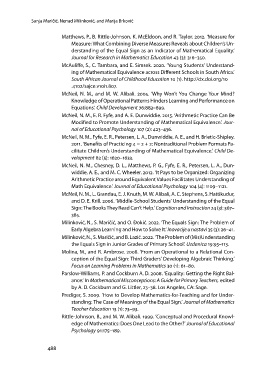Page 488 - Istenič Andreja, Gačnik Mateja, Horvat Barbara, Kukanja Gabrijelčič Mojca, Kiswarday Vanja Riccarda, Lebeničnik Maja, Mezgec Maja, Volk Marina. Ur. 2023. Vzgoja in izobraževanje med preteklostjo in prihodnostjo. Koper: Založba Univerze na Primorskem
P. 488
ja Maričić, Nenad Milinković, and Marija Brković
Matthews, P., B. Rittle-Johnson, K. McEldoon, and R. Taylor. 2012. ‘Measure for
Measure: What Combining Diverse Measures Reveals about Children’s Un-
derstanding of the Equal Sign as an Indicator of Mathematical Equality.’
Journal for Research in Mathematics Education 43 (3): 316–350.
McAuliffe, S., C. Tambara, and E. Simsek. 2020. ‘Young Students’ Understand-
ing of Mathematical Equivalence across Different Schools in South Africa.’
South African Journal of Childhood Education 10 (1). http://dx.doi.org/10
.4102/sajce.v10i1.807.
McNeil, N. M., and M. W. Alibali. 2005. ‘Why Won’t You Change Your Mind?
Knowledge of Operational Patterns Hinders Learning and Performance on
Equations.’ Child Development 76:883–899.
McNeil, N. M., E. R. Fyfe, and A. E. Dunwiddie. 2015. ‘Arithmetic Practice Can Be
Modified to Promote Understanding of Mathematical Equivalence.’ Jour-
nal of Educational Psychology 107 (2): 423–436.
McNeil, N. M., Fyfe, E. R., Petersen, L. A., Dunwiddie, A. E., and H. Brletic-Shipley.
2011. ‘Benefits of Practicing 4 = 2 + 2: Nontraditional Problem Formats Fa-
cilitate Children’s Understanding of Mathematical Equivalence.’ Child De-
velopment 82 (5): 1620–1633.
McNeil, N. M., Chesney, D. L., Matthews, P. G., Fyfe, E. R., Petersen, L. A., Dun-
widdie, A. E., and M. C. Wheeler. 2012. ‘It Pays to be Organized: Organizing
Arithmetic Practice around Equivalent Values Facilitates Understanding of
Math Equivalence.’ Journal of Educational Psychology 104 (4): 1109–1121.
McNeil, N. M., L. Grandau, E. J. Knuth, M. W. Alibali, A. C. Stephens, S. Hattikudur,
and D. E. Krill. 2006. ‘Middle-School Students’ Understanding of the Equal
Sign: The Books They Read Can’t Help.’ Cognition and Instruction 24 (3): 367–
385.
Milinković, N., S. Maričić, and O. Ðokić. 2022. ‘The Equals Sign: The Problem of
Early Algebra Learning and How to Solve It.’ Inovacije u nastavi 35 (3): 26–41.
Milinković, N., S. Maričić, and B. Lazić. 2022. ‘The Problem of (Mis)Understanding
the Equals Sign in Junior Grades of Primary School.’ Uzdanica 19:95–113.
Molina, M., and R. Ambrose. 2008. ‘From an Operational to a Relational Con-
ception of the Equal Sign: Third Graders’ Developing Algebraic Thinking.’
Focus on Learning Problems in Mathematics 30 (1): 61–80.
Parslow-Williams, P. and Cockburn A. D. 2008. ‘Equality: Getting the Right Bal-
ance.’ In Mathematical Misconceptions: A Guide for Primary Teachers, edited
by A. D. Cockburn and G. Littler, 23–38. Los Angeles, CA: Sage.
Prediger, S. 2009. ‘How to Develop Mathematics-for-Teaching and for Under-
standing: The Case of Meanings of the Equal Sign.’ Journal of Mathematics
Teacher Education 13 (1): 73–93.
Rittle-Johnson, B., and M. W. Alibali. 1999. ‘Conceptual and Procedural Knowl-
edge of Mathematics: Does One Lead to the Other?’ Journal of Educational
Psychology 91:175–189.
488
Matthews, P., B. Rittle-Johnson, K. McEldoon, and R. Taylor. 2012. ‘Measure for
Measure: What Combining Diverse Measures Reveals about Children’s Un-
derstanding of the Equal Sign as an Indicator of Mathematical Equality.’
Journal for Research in Mathematics Education 43 (3): 316–350.
McAuliffe, S., C. Tambara, and E. Simsek. 2020. ‘Young Students’ Understand-
ing of Mathematical Equivalence across Different Schools in South Africa.’
South African Journal of Childhood Education 10 (1). http://dx.doi.org/10
.4102/sajce.v10i1.807.
McNeil, N. M., and M. W. Alibali. 2005. ‘Why Won’t You Change Your Mind?
Knowledge of Operational Patterns Hinders Learning and Performance on
Equations.’ Child Development 76:883–899.
McNeil, N. M., E. R. Fyfe, and A. E. Dunwiddie. 2015. ‘Arithmetic Practice Can Be
Modified to Promote Understanding of Mathematical Equivalence.’ Jour-
nal of Educational Psychology 107 (2): 423–436.
McNeil, N. M., Fyfe, E. R., Petersen, L. A., Dunwiddie, A. E., and H. Brletic-Shipley.
2011. ‘Benefits of Practicing 4 = 2 + 2: Nontraditional Problem Formats Fa-
cilitate Children’s Understanding of Mathematical Equivalence.’ Child De-
velopment 82 (5): 1620–1633.
McNeil, N. M., Chesney, D. L., Matthews, P. G., Fyfe, E. R., Petersen, L. A., Dun-
widdie, A. E., and M. C. Wheeler. 2012. ‘It Pays to be Organized: Organizing
Arithmetic Practice around Equivalent Values Facilitates Understanding of
Math Equivalence.’ Journal of Educational Psychology 104 (4): 1109–1121.
McNeil, N. M., L. Grandau, E. J. Knuth, M. W. Alibali, A. C. Stephens, S. Hattikudur,
and D. E. Krill. 2006. ‘Middle-School Students’ Understanding of the Equal
Sign: The Books They Read Can’t Help.’ Cognition and Instruction 24 (3): 367–
385.
Milinković, N., S. Maričić, and O. Ðokić. 2022. ‘The Equals Sign: The Problem of
Early Algebra Learning and How to Solve It.’ Inovacije u nastavi 35 (3): 26–41.
Milinković, N., S. Maričić, and B. Lazić. 2022. ‘The Problem of (Mis)Understanding
the Equals Sign in Junior Grades of Primary School.’ Uzdanica 19:95–113.
Molina, M., and R. Ambrose. 2008. ‘From an Operational to a Relational Con-
ception of the Equal Sign: Third Graders’ Developing Algebraic Thinking.’
Focus on Learning Problems in Mathematics 30 (1): 61–80.
Parslow-Williams, P. and Cockburn A. D. 2008. ‘Equality: Getting the Right Bal-
ance.’ In Mathematical Misconceptions: A Guide for Primary Teachers, edited
by A. D. Cockburn and G. Littler, 23–38. Los Angeles, CA: Sage.
Prediger, S. 2009. ‘How to Develop Mathematics-for-Teaching and for Under-
standing: The Case of Meanings of the Equal Sign.’ Journal of Mathematics
Teacher Education 13 (1): 73–93.
Rittle-Johnson, B., and M. W. Alibali. 1999. ‘Conceptual and Procedural Knowl-
edge of Mathematics: Does One Lead to the Other?’ Journal of Educational
Psychology 91:175–189.
488


